 |
August 2014
|
August 2014 // Volume 52 // Number 4 // Research In Brief // v52-4rb5
Using Citizen Scientists to Evaluate Light Traps for Catching Brown Marmorated Stink Bugs in Homes in Virginia
Abstract
More and more, citizen scientists are playing an integral role in research studies. This has been particularly evident as entomologists unravel the biology, spread, and management of the brown marmorated stink bug, which has plagued many homeowners in the mid-Atlantic U.S. in recent years. We used citizen scientists to evaluate different indoor light traps for catching the bugs in houses. Throughout the late winter and early spring months, these traps were tested inside homes and enabled us to determine that the most efficacious trap was an aluminum foil water pan trap, developed by—you guessed it—a citizen scientist.
Introduction
Citizen science, or public participation in research, can be a useful and efficient strategy for collecting certain scientific research data (Salmon et al., 2008). Collaborations between research scientists and citizen scientists have the potential to broaden the scope of research and enhance the ability to collect data (Cohn, 2008). Moreover, based on the type of data required, labor needs, budget limitations, and the urgency of the situation, citizen involvement may be the only feasible means for conducting specific studies (Jimmerson, 1981; Silvertown, 2009).
We discovered this recently with our research on the invasive pest insect, brown marmorated stink bug (BMSB), Halyomorpha halys. After its accidental introduction into eastern Pennsylvania in the mid-1990s, BMSB spread rapidly through the mid-Atlantic U.S., becoming an ever-increasing nuisance pest during the fall and winter months in households and commercial buildings as well as a serious agricultural pest of tree fruit, vegetables, and other crops (Hamilton, 2009; Kuhar, et al., 2012; Leskey et al., 2012). Citizen scientists have contributed valuable data for tracking the spread of this insect into new regions. Websites for reporting the insect have been established at Rutgers University (http://njaes.rutgers.edu/stinkbug/) and Pennsylvania State University (http://www.Stinkbug-info.org), and these data have enabled scientists to follow the bug's invasion across North America and to estimate the rate of spread. Also, with the help of Extension-run Master Gardener programs and communication networks, researchers have been able to obtain useful information on which plants this invasive stink bug utilizes for food and development (Bergmann et al., 2013).
Citizen scientists have contributed in other ways as well. Because BMSB uses man-made structures such as attics, garages, offices, and other buildings to overwinter (Hamilton, 2009; Inkley, 2012), citizens have monitored when, where, and how the bugs enter houses as well as how many. In 2011, one homeowner from Maryland collected over 26,000 BMSB in his house from January to June (Inkley, 2012). Throughout the winter and spring, especially on warmer days, BMSB become active indoors, often finding their way into living areas. This nuisance factor has inspired citizens to develop creative ways of ridding their homes of these creatures. While the best defense for BMSB is sealing windows, doors, and other small access points (Day, McCoy, Miller, Kuhar, & Pfeiffer, 2011), this may not always be effective or possible because of the importance of airflow and the functionality of building products designed for expansion and contraction.
Like many other insects, BMSB are attracted to lights at night (Nielsen, Holmstrom, Hamilton, Cambridge, & Ingerson-Mahar, 2013). Citizen scientists in the U.S. recognized this behavioral phenomenon within their homes and explored ways to trap BMSB using lights in a dark room. Various trap designs and homemade devices began appearing on the Internet, including a reflective pan of water with a light source directed down on it and a plastic two-liter bottle trap with an inverted top and LED light inside to attract the bugs (http://www.youtube.com/watch?v=zKc5acECuQk). One homeowner from Pennsylvania designed and patented his stink bug light trap and started a business, Strube's Stink Bug Traps LLC, Columbia, PA (http://www.stinkbugtrapsonline.com/). Other commercial light traps began appearing in hardware stores in 2010, including the Rescue Trap (http://www.rescue.com/product/reusable-indoor-stink-bug-trap).
Our study was designed to evaluate the effectiveness of various light traps for the trapping of BMSB inside of homes. Two traps were homemade, while two others were commercially available. In order to achieve the necessary replications for our experiment, we involved Virginia Cooperative Extension agents to help us recruit 14 citizen scientists who were interested in conducting the study in their homes in 2012 or 2013.
Materials and Methods
Experiments were conducted during the winter and spring in homes in Giles, Loudoun, or Montgomery Counties, Virginia in 2012 and 2013. Study sites were selected by identifying 16 volunteers who had sufficient stink bug infestations based upon phone or email complaints to Virginia Cooperative Extension agents and were interested and willing to conduct the experiment. Because BMSB is the only known stink bug in North America that overwinters in man-made structures, we were certain that participants were able to positively identify the insect.
In 2012, four traps were tested, including the Sterling Rescue® Stink Bug Trap (Figure 1), the Strube Stink Bug Trap (Figure 2), aluminum pan trap with soapy water and a desk lamp shining on it (Figure 3), and a 2-liter bottle trap (Figure 4). The costs to either purchase or make these traps were approximately $30, $50, $10, and $7 for the Sterling Rescue, Strube, aluminum pan, and 2-liter bottle traps, respectively. The Rescue® Stink Bug Traps and light attachments were purchased from Lowes. The Strube Stink Bug Traps were donated by the company. The 2-liter bottle trap was constructed according to Smith (2011) by cutting the top off of a 2-liter soda bottle and inverting it to make a funnel. A Sylvania Dot-It battery powered LED light was placed in the bottom of the bottle, and masking tape on the sides of the bottle allowed for a rough surface for the BMSB to grasp. The bottom of the bottle was wrapped in black 3M electrical tape to ensure that the light was coming from the top of the trap (Smith 2011). First brought to our attention by the Catoctin Creek Scenic River Advisory Committee of Loudoun County, Virginia, the water pan trap was simply an aluminum foil roasting pan (29.8cm x 23.8cm x 5.9cm) with approximately 1-liter of water: 1 mL Dawn dish detergent mixture in the bottom of the pan. A desk lamp with a 13W CFL light bulb was placed next to the pan and pointed into the pan. In 2013, the Strube Stink Bug Trap was excluded from the experiment because the trap was discontinued and not available in 2013.
Figure 1.
Aluminum Foil Pan Trap with soapy Water in Action in a Home in Loudoun County, Virginia

Figure 2.
Commercially Available 2011 Strube's Stink Bug Trap
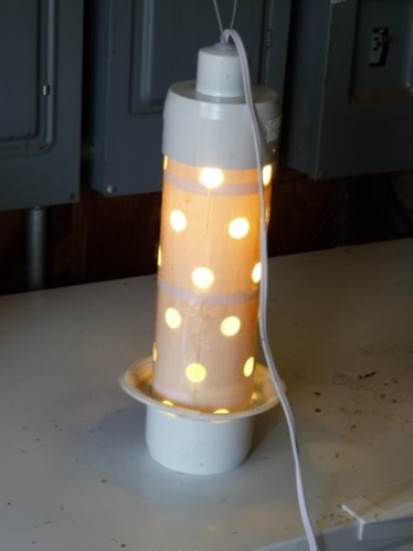
Figure 3.
Homemade 2-Liter Bottle Trap with LED Press-on Light in the Bottom
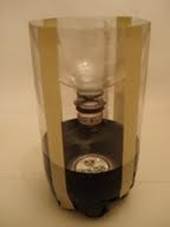
Figure 4.
Rescue® Stink Bug Trap in a Home in Loudoun County, Virginia in 2013
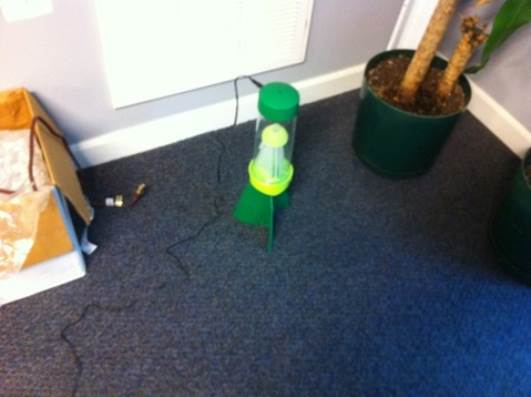
All locations were provided with one of each trap and all materials necessary to conduct these tests, including batteries and extension cords. Within each home, individual traps were each placed in a separate room for approximately 1 week. The light source for traps were either manually turned on for LED light in the 2-liter bottle trap, or automatically turned on using a Brinks Timer set for 12 hours daily from 7PM – 7AM. Each week throughout the duration of the experiment, the total number of BMSB adults was counted and reported by the homeowners. After each count, traps at location 1 were moved to location 2; location 2 to location 3; location 3 to location 4; and location 4 to location 1. This was repeated each week for the duration of the project.
All data were analyzed using JMP Pro 10 (SAS Inst. 2007, Cary, NC). ANOVA was conducted and followed by a Student's t-test to evaluate significant difference of the number of BMSB caught per trap (α=0.05).
Results
From 2012 to 2013, there were a total of 14 participants (72%) who reported stink bug trap catch data for a minimum of 4 weeks (Figure 5). These data were used for statistical analysis.
Figure 5.
Mean (±SE) Number of Stink Bugs Caught by Week in all Light Traps Placed in Houses in Virginia by Citizen Scientists in 2012 and 2013
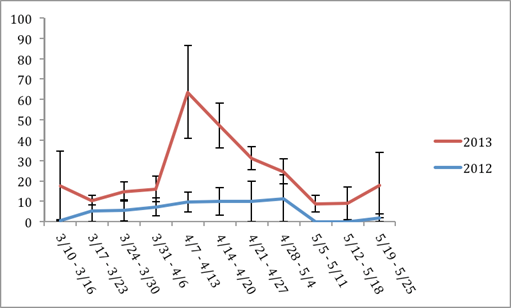
In 2012, significantly more BMSB were caught in both the Strube and aluminum foil pan traps over the weekly observation period (Figure 6; F = 11.12; dF = 3; p < 0.0001). In 2013, the aluminum foil water pan trap caught 19 times more BMSB adults than the other two traps (Figure 7, a difference that was highly significant; F = 25.91; dF = 2; p < 0.0001*). The Strube trap was omitted from our analysis because of its exclusion in 2013.
Figure 6.
Cumulative Mean (±SE) Number of BMSB Adults Captured per Trap per Week in 2012

Figure 7.
Cumulative Mean (±SE) Number of BMSB Adults Captured per Trap per Week in 2013
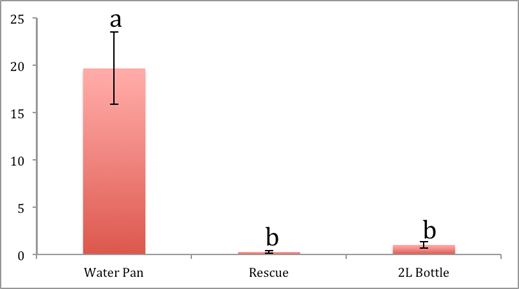
Discussion
Excluding the Strube trap, which discontinued the model that we tested in 2012, the aluminum foil pan trap was the most effective device for trapping BMSB in homes during the winter and spring. Some individuals reported bug catch as high as 144 per week using this homemade trap. Although this trap may not remove every stink bug from a building, it will provide homeowners with some relief from their stink bug infestations, as well as a sense of satisfaction from removing large numbers of the bugs from their homes. This information should be of immediate value to many Extension personnel in the mid-Atlantic U.S., who have been asked the popular question, "How do I get rid of stink bugs?"
Our study is also valuable for Extension in other ways. As Extension agents seldom have the resources or time to adequately conduct research studies that could provide answers to problems that are plaguing their clientele, the study reported here shows them that using citizen scientists may enable them to conduct practical applied research. Based on the nature of our study, which involved trapping stink bugs from infested houses, there was no more efficient way to collect these data than to use citizen scientists. Because our participants cohabitate with these insects, they had a vested interest in the experiment. Some of our participants used the experience as a teaching tool for their families, such as an opportunity for children to learn how to count or to learn about the scientific process. Another benefit to using citizen scientists was that the experiment had an immediate impact because participants knew the outcome of the experiment and disseminated the results themselves via word of mouth. Although the outcome of the experiment was published in some local newspapers, many citizens within the counties where the testing took place had already heard about the experiment.
Acknowledgements
We would like to thank the Catoctin Creek Scenic River Advisory Committee, Tami Carlow, and all of the volunteers who allowed us to use their homes for their dedication and assistance with this project. This research was supported in part by USDA-NIFA SCRI award #2011-51181-30937.
References
Bergmann, E., Bernhard, K. M., Bernon, G., Bickerton, M., Gill, S., Gonzales, C. Hamilton, G. C., Hedstrom, C., Kamminga, K., Koplinka-Loehr, C., Krawczyk, G., Kuhar, T. P., Kunkel, B., Lee, J., Leskey, T. C., Martinson, H., Nielsen, A. L., Raupp, M., Shearer, P., Shrewsbury, P., Walgenbach, J., Whalen, J., & Wiman, N. (2013). Host plants of the brown marmorated stink bug in the U.S. Northeastern IPM Center Technical Bulletin. Retrieved from: http://www.stopbmsb.org/where-is-bmsb/host-plants
Cohn, J. P. (2008). Citizen science: Can volunteers do real research? Bioscience, 58(3). 192. doi: 10.1641/b580303.
Day, E. R., McCoy, T., Miller, D., Kuhar, T. P., & Pfeiffer, D. G. (2011). Brown marmorated stink bug. Virginia Cooperative Extension. Pub. No. 2902-1100. Retrieved from: http://www.pubs.ext.vt.edu/2902/2902-1100/2902-1100.html
Hamilton, G. C. (2009). Brown marmorated stink Bug. American Entomologist, Spring 2009. 55: 19-20.
Inkley, D. B. (2012). Characteristics of home invasion by the brown marmorated stink bug (Hemiptera: Pentatomidae). Journal of Entomological Science, 47: 125 - 130.
Jimmerson, R. M. (1981). What determines citizen involvement? Journal of Extension [On-line], 19(5). Available at: http://www.joe.org/joe/1981september/81-5-a3.pdf
Kuhar, T. P., Kamminga K. L., Whalen, J., Dively G. P., Brust, G., Hooks, C. R. R., Hamilton, G., & Herbert, D. A. (2012). The pest potential of brown marmorated stink bug on vegetable crops. Plant Health Progress, doi: 10.1094/PHP-2012-0523-01-BR
Leskey, T. C., Hamilton, G. C., Nielsen, A. L., Polk, D., Rodriguez-Saona, C., Bergh, J. C., Herbert, D. A., Kuhar, T., Pfeiffer, D., Dively, G., Hooks, C., Raupp, M., Shrewsbury, P., Krawczyk, G., Shearer, P. W., Whalen, J., Koplinka-Loehr, C., Myers, E., Inkley, D., Hoelmer, K., Lee, D-H., & Wright, S. E. (2012). Pest status of the brown marmorated stink bug, Halyomorpha halys in the USA. Outlooks on Pest Management, 23: 218-226. doi: 10.1564/23oct07
Nielsen, A. L., Holmstrom, K., Hamilton, G. C., Cambridge, J. & Ingerson-Mahar, J. (2013). Use of black light traps to monitor the abundance, spread, and flight behavior of Halyomorpha halys (Hemiptera: Pentatomidae). Journal of Economic Entomology, 106(3): 1495-1502. doi: 10.1603/EC12472
Salmon, T. P., Faber, B., Bender, G., Shaw, D., Kowalski, V. J., & Berentsen, A. (2008). Volunteer researchers: Moving beyond cooperators. Journal of Extension [On-line], 46(2) Article 2FEA7. Available at: http://www.joe.org/joe/2008april/a7.php
SAS Institute, Inc. (2007). JMP user's guide. Cary, NC: SAS Institute Inc.
Silvertown, J. (2009). A new dawn for citizen science. Trends in Ecology and Evoloution, 24(9): 467 – 470.




